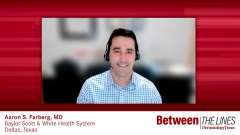
Current Treatments for Generalized Pustular Psoriasis
Experts in dermatology review data on various treatment interventions before, during, and after generalized pustular psoriasis flare episodes.
Episodes in this series

Aaron S. Farberg, MD: Treatments; we have this disease, what are we doing to treat it? What are we doing during and after the GPP [generalized pustular psoriasis] flare episodes? Let’s take a look. You can see looking at the flare percentage; we’re using a variety of different treatments. I had to turn my head to the side here. I was like, whoa, everybody’s using a variety of different things, including opioids. That’s actually a significant percentage there, highlighting the importance of that No. 1 symptom, which is pain. What would you say would be your go-to here, and what do you think of these data, Dr Crowley?
Jeffrey Crowley, MD: These data show how this is a disease that needs a unified treatment approach. These are miserable data. It looks like a lot of patients aren’t really getting anything, or very little, in terms of intervention. Some of these patients may just be going through the flare and resolving on their own to some extent. Topical corticosteroids obviously can be very helpful, especially with occlusion. Oral corticosteroids, usually we’re trying to avoid those in patients with pustular psoriasis, because steroids can be an inducer of pustular psoriasis. Patients who are being weaned off steroids for other conditions or being treated regularly with IM [intramuscular injection] Kenalog for psoriasis can undergo a pustular flare. That’s probably not something you want to do chronically for these patients, but you may have to have some steroids on board because some of these patients may have adrenal insufficiency and may need an acute dose. The steroids are fine as long as you’re putting something else on board as well.
What are those other things you’re putting on board? Well, a bit of TNF [tumor necrosis factor] inhibitor, a bit of interleukins, some PD4 [phosphodiesterase-4] inhibitors, and a few oral retinoids. Traditionally, I’ve used an IL-17 up front because I can get easy access to that in my refrigerator. There are samples, and I can start that right away. Although it’s not directly targeting what’s going on with this disease, it can help you get some turnaround there, but it often needs more than 1 treatment. I think if there was a bar for “some of the above,” I think that would be the highest treatment bar in this graph.
Aaron S. Farberg, MD: That’s a good point. I think it would be important to delineate these data as to who is actually prescribing it. I would’ve liked, or I would’ve hoped that we would’ve seen an increase in the TNF, or the IL and PD4 inhibitors. Again, you see a lot of oral corticosteroids, which leads back to your story, Dr Crowley, if they’re in an urgent care, what are they going to get? A bunch of IV antibiotics and steroids as well, which again, it’s the steroids and coming off of them that can often lead to a disease like GPP. It’s quite well known. It’d be interesting to dive into those data a little deeper. I don’t think we have the slides on that, but that’s why you’ve got to download the paper and read it for yourself as well.
Moving on to the next comparison of treatments between patients with GPP who did have documented episodes and those who did not. So those who actually had a documented flare and those who did not. You can see what were they mostly given: topical steroids, opioids, and oral corticosteroids. What is going on here, Dr Crowley?
Jeffrey Crowley, MD: It’s a mess. Again, that hearkens to the problem with this disease, it’s getting to the person who can make the right diagnosis and get you on some treatment that’s going to address the type of inflammation that’s going on. It is heartening to see that patients with flares are at least getting more treatment. That’s pretty much what this graph shows me, and that’s about it.
Aaron S. Farberg, MD: It’s definitely an opportunity and a gap that needs to be closed to find more unified treatments, treatments that will actually provide improvement. I do a lot of surgery, so everyone always asks me, what’s the best scar gel? What’s the best scar cream? I say there are a thousand of them out there, which means that there’s not 1 that really works well, because if there was 1, everyone would use it. That’s kind of the analogy hat I see here. We have lots of treatments, but if there were 1 that worked very well, we would all use it. I know we’re excited to have at least 1 that is approved for GPP and will have a strong impact on our patients. We’re excited to see how our colleagues will utilize it.
Transcript edited for clarity
Newsletter
Like what you’re reading? Subscribe to Dermatology Times for weekly updates on therapies, innovations, and real-world practice tips.



















